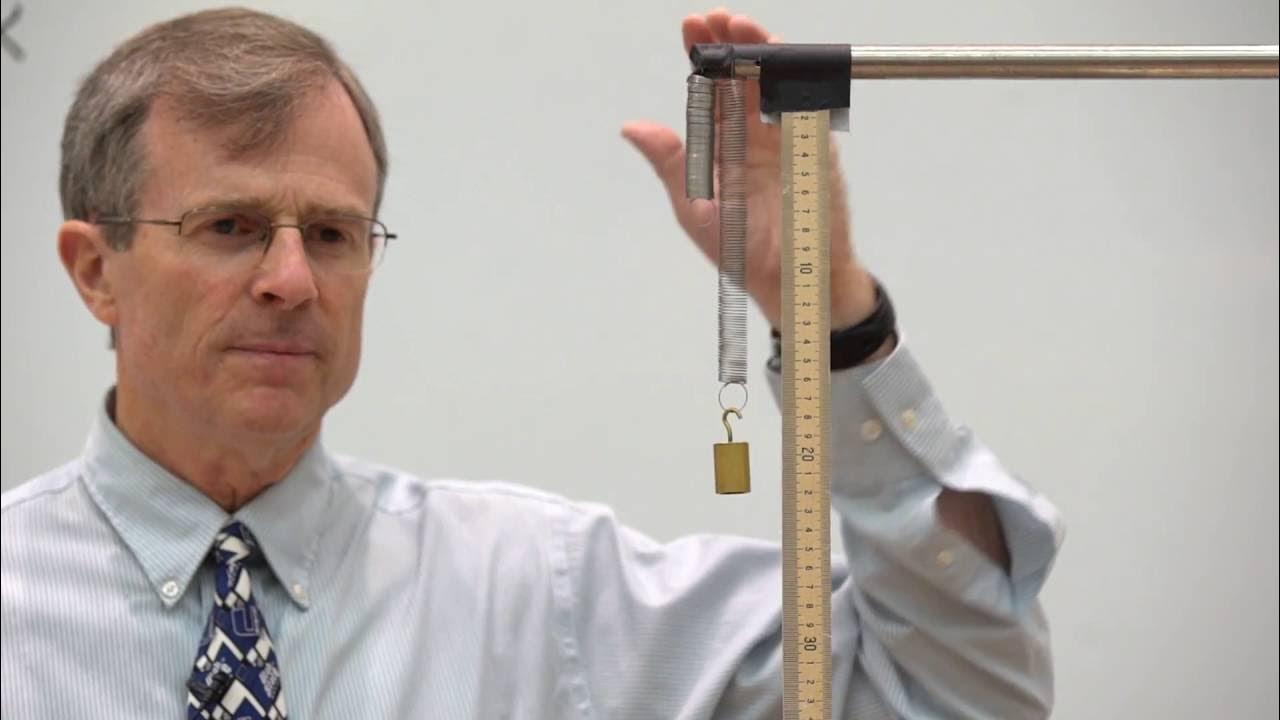Horizontal vs. Vertical Mass-Spring System
Summary
TLDRIn this video, the instructor addresses a misunderstanding about a horizontal mass-spring system demonstrated in previous lessons. The surface was not truly frictionless, and the system wasn't horizontal—it was a vertical system rotated 90 degrees. The instructor explains that while the system behaves similarly in both orientations, the forces involved differ due to gravity in the vertical setup. The instructor also clarifies that the demo was slowed down for better understanding and reiterates the importance of simple harmonic motion in both systems. The session concludes with appreciation for the class's learning efforts.
Takeaways
- 😀 The surface the mass is sliding on in the demonstration is assumed to be frictionless, though this is physically impossible.
- 😀 Despite the assumption of a frictionless surface, the demo shows the mass not slowing down at all, which is unrealistic without friction.
- 😀 The video of the mass-spring system was looped, showing the same cycle repeatedly rather than a continuous motion.
- 😀 The mass-spring system shown in the video is actually vertical, not horizontal, and was rotated 90 degrees for the demonstration.
- 😀 The horizontal and vertical mass-spring systems behave similarly, but in a vertical system, the mass oscillates around a lower equilibrium position.
- 😀 In the vertical mass-spring system, the net force in the vertical (y) direction equals zero when the spring force balances the force of gravity.
- 😀 The restoring force in a vertical mass-spring system is the combination of the spring force and the force of gravity, both acting in opposite directions.
- 😀 In a horizontal mass-spring system, the only force acting in the x-direction is the spring force, which provides the restoring force for simple harmonic motion.
- 😀 Both horizontal and vertical mass-spring systems exhibit simple harmonic motion, with the mass oscillating back and forth between positions.
- 😀 The video of the mass-spring system was slowed down to one-eighth of its normal speed to make the motion easier to understand.
Q & A
Why did the instructor state that the surface the mass was sliding on was frictionless in the previous lessons?
-The instructor made this claim to simplify the system for the demonstration of the mass-spring system's oscillatory behavior, even though friction is inherently present in real systems.
How did the instructor address the apparent contradiction of the mass not slowing down despite friction being present?
-The instructor clarified that the video was looped, showing a single cycle of the system repeatedly, making it seem like the mass was not slowing down.
What did the instructor reveal about the nature of the system used in the demonstration?
-The instructor revealed that it was actually a vertical mass-spring system rotated 90 degrees to appear as a horizontal one.
Is it considered 'cheating' to rotate a vertical mass-spring system to make it look horizontal?
-No, it is not considered cheating because horizontal and vertical mass-spring systems behave similarly, with only the direction of oscillation changing.
What is the primary difference between a horizontal and a vertical mass-spring system?
-In a vertical mass-spring system, the mass oscillates around a position lower than the equilibrium due to gravity, while in a horizontal system, the mass oscillates along the horizontal axis with only the spring force acting.
What forces are involved in the motion of a vertical mass-spring system?
-In a vertical system, the restoring force includes both the upward spring force and the downward force of gravity.
What forces act in a horizontal mass-spring system?
-In a horizontal system, the only force acting is the horizontal spring force, which causes the restoring force.
What is the significance of the motion pattern (1 to 2 to 3 to 2 to 1) mentioned by the instructor?
-This pattern represents the oscillatory motion of the mass, where it moves back and forth in simple harmonic motion between different positions.
Why did the instructor slow the video of the mass-spring system to one-eighth its normal speed?
-The video was slowed down to make it easier for students to observe and understand the motion of the system, as normal speed would make it more difficult to follow.
What was the overall purpose of the demonstration and explanation?
-The purpose was to clarify how horizontal and vertical mass-spring systems work, demonstrate their similarities, and explain the simplification made for teaching purposes, ensuring the concepts of oscillatory motion are understood.
Outlines

This section is available to paid users only. Please upgrade to access this part.
Upgrade NowMindmap

This section is available to paid users only. Please upgrade to access this part.
Upgrade NowKeywords

This section is available to paid users only. Please upgrade to access this part.
Upgrade NowHighlights

This section is available to paid users only. Please upgrade to access this part.
Upgrade NowTranscripts

This section is available to paid users only. Please upgrade to access this part.
Upgrade NowBrowse More Related Video

Simple Harmonic Motion Introduction(SHM) via a Horizontal Mass-Spring System

De qué depende el periodo para una masa en un resorte | Física | Khan Academy en Español

Força Peso e lei de Hooke

Simple Harmonic Motion(SHM) - Graphs of Mechanical Energies

Getaran Bebas Teredam - Persamaan Gerak

Oscillations Demo: Mass Spring System
5.0 / 5 (0 votes)